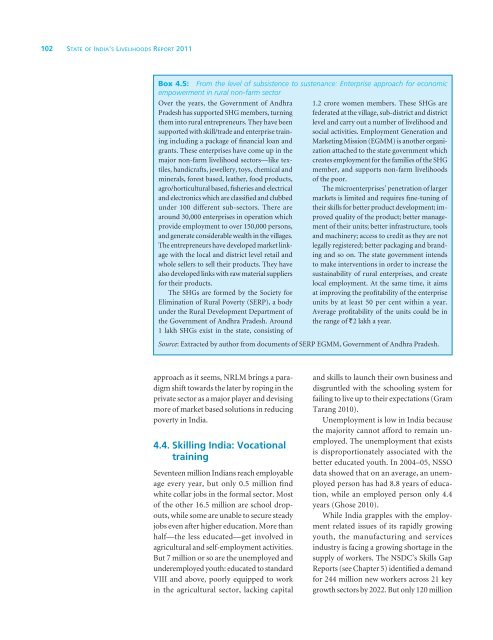SOIL Report 2011 - ACCESS Development Services
SOIL Report 2011 - ACCESS Development Services
SOIL Report 2011 - ACCESS Development Services
- No tags were found...
You also want an ePaper? Increase the reach of your titles
YUMPU automatically turns print PDFs into web optimized ePapers that Google loves.
102 State of India’s Livelihoods <strong>Report</strong> <strong>2011</strong>Box 4.5: From the level of subsistence to sustenance: Enterprise approach for economicempowerment in rural non-farm sectorOver the years, the Government of AndhraPradesh has supported SHG members, turningthem into rural entrepreneurs. They have beensupported with skill/trade and enterprise trainingincluding a package of financial loan andgrants. These enterprises have come up in themajor non-farm livelihood sectors—like textiles,handicrafts, jewellery, toys, chemical andminerals, forest based, leather, food products,agro/horticultural based, fisheries and electricaland electronics which are classified and clubbedunder 100 different sub-sectors. There arearound 30,000 enterprises in operation whichprovide employment to over 150,000 persons,and generate considerable wealth in the villages.The entrepreneurs have developed market linkagewith the local and district level retail andwhole sellers to sell their products. They havealso developed links with raw material suppliersfor their products.The SHGs are formed by the Society forElimination of Rural Poverty (SERP), a bodyunder the Rural <strong>Development</strong> Department ofthe Government of Andhra Pradesh. Around1 lakh SHGs exist in the state, consisting of1.2 crore women members. These SHGs arefederated at the village, sub-district and districtlevel and carry out a number of livelihood andsocial activities. Employment Generation andMarketing Mission (EGMM) is another organizationattached to the state government whichcreates employment for the families of the SHGmember, and supports non-farm livelihoodsof the poor.The microenterprises’ penetration of largermarkets is limited and requires fine-tuning oftheir skills for better product development; improvedquality of the product; better managementof their units; better infrastructure, toolsand machinery; access to credit as they are notlegally registered; better packaging and brandingand so on. The state government intendsto make interventions in order to increase thesustainability of rural enterprises, and createlocal employment. At the same time, it aimsat improving the profitability of the enterpriseunits by at least 50 per cent within a year.Average profitability of the units could be inthe range of `2 lakh a year.Source: Extracted by author from documents of SERP EGMM, Government of Andhra Pradesh.approach as it seems, NRLM brings a paradigmshift towards the later by roping in theprivate sector as a major player and devisingmore of market based solutions in reducingpoverty in India.4.4. Skilling India: VocationaltrainingSeventeen million Indians reach employableage every year, but only 0.5 million findwhite collar jobs in the formal sector. Mostof the other 16.5 million are school dropouts,while some are unable to secure steadyjobs even after higher education. More thanhalf—the less educated—get involved inagricultural and self-employment activities.But 7 million or so are the unemployed andunderemployed youth: educated to standardVIII and above, poorly equipped to workin the agricultural sector, lacking capitaland skills to launch their own business anddisgruntled with the schooling system forfailing to live up to their expectations (GramTarang 2010).Unemployment is low in India becausethe majority cannot afford to remain unemployed.The unemployment that existsis disproportionately associated with thebetter educated youth. In 2004–05, NSSOdata showed that on an average, an unemployedperson has had 8.8 years of education,while an employed person only 4.4years (Ghose 2010).While India grapples with the employmentrelated issues of its rapidly growingyouth, the manufacturing and servicesindustry is facing a growing shortage in thesupply of workers. The NSDC’s Skills Gap<strong>Report</strong>s (see Chapter 5) identified a demandfor 244 million new workers across 21 keygrowth sectors by 2022. But only 120 million














